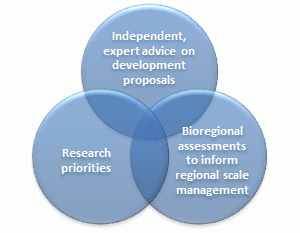The Independent Expert Scientific Committee on Unconventional Gas Development and Large Coal Mining Development (IESC) provides advice to the Australian Government Environment Minister on priorities for research to improve the understanding of potential impacts on water resources (surface waters, groundwaters and their dependent ecosystems) from unconventional gas and large coal mining developments.

2017 research priorities
In 2017 and as part of its mandate (About the IESC), the IESC recommended some research priorities to the Australian Government. These priorities relate to the potential impacts on water resources (including changes to hydrology and water quality) that may arise from large coal mining and coal seam gas developments. The research priorities focused on issues of national significance, areas of high-risk to water resources and areas where there are major knowledge gaps.
The 2017 research priorities were grouped into 3 main themes:
- Hydrology: address gaps in knowledge on surface water and groundwater connectivity, groundwater modelling, and impacts on water bodies.
- Chemicals: improve understanding of chemicals used in coal seam gas extraction and their movement in surface waters and groundwaters, wastewater management and geogenic (naturally occurring under the ground) chemicals.
- Ecology: improve understanding of the ecological impacts of changes to water quantity, quality, and flow; and explore better ways to monitor and mitigate the effects of coal seam gas and coal mining on aquatic ecosystems, key species and ecological communities.
For more detailed information about the 2017 research priorities, visit IESC Priorities for Research | iesc.
Research projects
The IESC has supported several projects under the broad scope of its 2017 research priorities. These projects include:
Coal mine voids in Queensland
The IESC funded a research pilot project to increase the understanding of coal mine voids in Queensland through a scoping study to identify the location and potential impacts of these mine voids on the landscape.
This study was finalised in November 2021. For more information, visit Scoping study - Coal mine voids, Queensland.
Metagenomic research project
The IESC funded a metagenomic research project under its Chemical and Ecology research priorities that evaluated how different sampling and analysis methods may influence assessment of the impacts of mining on groundwater ecosystems (biota and water chemistry). Conventional methods for collecting and processing samples from alluvial and sandstone aquifers in NSW were compared with metagenomic approaches.
This project concluded in April 2024. For more information, visit Metagenomic research project.
Information Guidelines Explanatory Note - Using impact pathway diagrams based on ecohydrological conceptualisation in environmental impact assessment
The IESC published an Explanatory Note to describe and promote the use of impact pathway diagrams based on ecohydrological conceptualisation in environmental impact assessments.
The Explanatory Note was published in 2024. For further information, visit Information Guidelines Explanatory Note - Using impact pathway diagrams based on ecohydrological conceptualisation in environmental impact assessment.
Completed research findings
The IESC has supported more than 55 publicly available research reports. This research has strengthened the science behind regulatory decisions by better informing the IESC's advice to regulators.
Research products and fact sheets on topics across the priority themes are available on the Department's website: Coal and coal seam gas - Resources. To download the technical reports, visit Coal and coal seam gas – Science and research.

